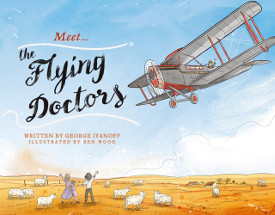Meet the Flying Doctors by George Ivanoff

Ill. by Ben Wood. Random House, Australia, 2016. ISBN 9780143780687
In 1911 John Flynn went to work on a mission more than 500
kilometres from Adelaide, the beginning of a journey for which
thousands of people have been grateful for over the decades since
then. In what is still a remote area, Flynn was greatly disturbed by
the lack of medical facilities beyond the metropolitan areas. Not
satisfied with patients being treated by those with a rudimentary
knowledge of first aid with support being sent in Morse code over
the telegraph system, while doctors could take weeks to reach them
using whatever transport was available; Flynn knew there had to be a
better way and so began his quest to find a solution.
Flight seemed the obvious answer but in those days both planes and
pilots were hard to come by and it took 10 years of campaigning
before his first plane was ready for service. In 1928, his dream
came true - he formed the Australian Inland Mission Aerial Medical
Service using a single-engine plane on loan from QANTAS aptly named
Victory. Immediately there was a difference - 50 missions and 255
patients treated in a year.
But they were not out of the woods yet - in fact they were a bit
lost over desert landscapes navigating by landmarks because there
were no radios in the planes. Even though it meant that they could
only fly at night in extreme emergencies, nevertheless the pilots
put their craft down in the most amazing places and with Alf
Traegar's invention of the pedal radio in 1929 at last the people of
the outback started to get the services they needed.
In 1955 the name was changed to the Royal Flying Doctor Service, and
one of Australia's most iconic institutions has gone from strength
to strength now servicing rural and remote areas from 23 bases
scattered around the country.
The story of the RFDS is one that every child should know - from
those in the cities where medical services on tap can be taken for
granted to those in the Outback where lives depend on it daily. It
is a rich and rewarding story of success and Ivanoff has managed to
cram so much information into just 32 pages while still keeping it
personal and connected to its child audience. Wood's illustrations
emphasise the isolation and enormity of the landscape adding weight
to the extent of the issue and the importance of its solution.
As always with this series, there is a timeline at the back that
encapsulates the milestones. Meet... is one of the most
significant series of biographies written for young Australian
readers as they are introduced to the diverse and critical
contributions that have been made by individuals to the development
of this nation.
Barbara Braxton